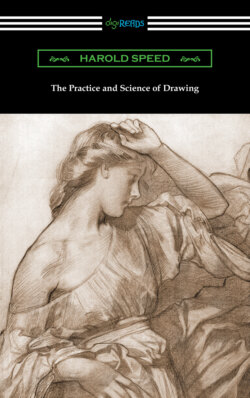Читать книгу The Practice and Science of Drawing - Harold Speed - Страница 23
На сайте Литреса книга снята с продажи.
ОглавлениеIf so early the sense of vision is neglected and relegated to be the handmaiden of other senses, it is no wonder that in the average adult it is in such a shocking state of neglect. I feel convinced that with the great majority of people vision is seldom if ever consulted for itself, but only to minister to some other sense. They look at the sky to see if it is going to be fine; at the fields to see if they are dry enough to walk on, or whether there will be a good crop of hay; at the stream not to observe the beauty of the reflections from the blue sky or green fields dancing upon its surface or the rich colouring of its shadowed depths, but to calculate how deep it is or how much power it would supply to work a mill, how many fish it contains, or some other association alien to its visual aspect. If one looks up at a fine mass of cumulus clouds above a London street, the ordinary passer-by who follows one’s gaze expects to see a balloon or a flying-machine at least, and when he sees it is only clouds he is apt to wonder what one is gazing at. The beautiful form and colour of the cloud seem to be unobserved. Clouds mean nothing to him but an accumulation of water dust that may bring rain. This accounts in some way for the number of good paintings that are incomprehensible to the majority of people. It is only those pictures that pursue the visual aspect of objects to a sufficient completion to contain the suggestion of these other associations, that they understand at all. Other pictures, they say, are not finished enough. And it is so seldom that a picture can have this petty realisation and at the same time be an expression of those larger emotional qualities that constitute good painting.
The early paintings of the Pre-Raphaelite Brotherhood appear to be a striking exception to this. But in their work the excessive realisation of all details was part of the expression and gave emphasis to the poetic idea at the basis of their pictures, and was therefore part of the artistic intention. In these paintings the fiery intensity with which every little detail was painted made their picture a ready medium for the expression of poetic thought, a sort of “painted poetry,” every detail being selected on account of some symbolic meaning it had, bearing on the poetic idea that was the object of the picture.
But to those painters who do not attempt “painted poetry,” but seek in painting a poetry of its own, a visual poetry, this excessive finish (as it is called) is irksome, as it mars the expression of those qualities in vision they wish to express. Finish in art has no connection with the amount of detail in a picture, but has reference only to the completeness with which the emotional idea the painter set out to express has been realised.
